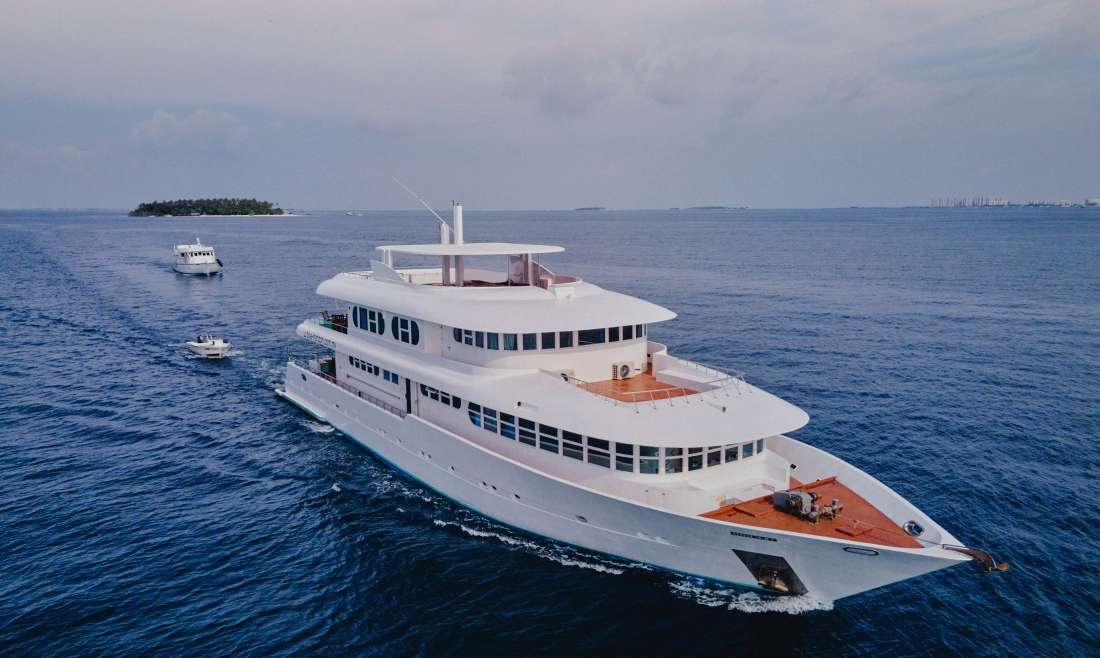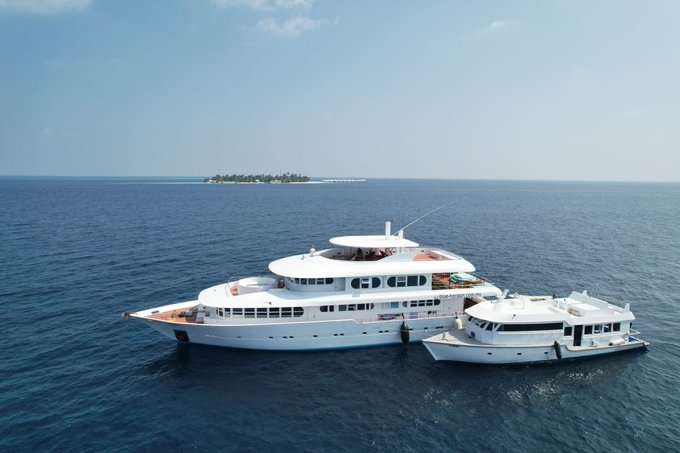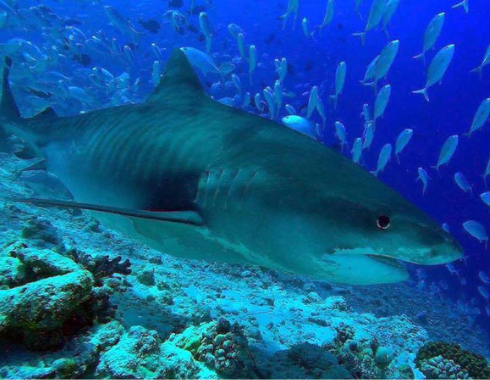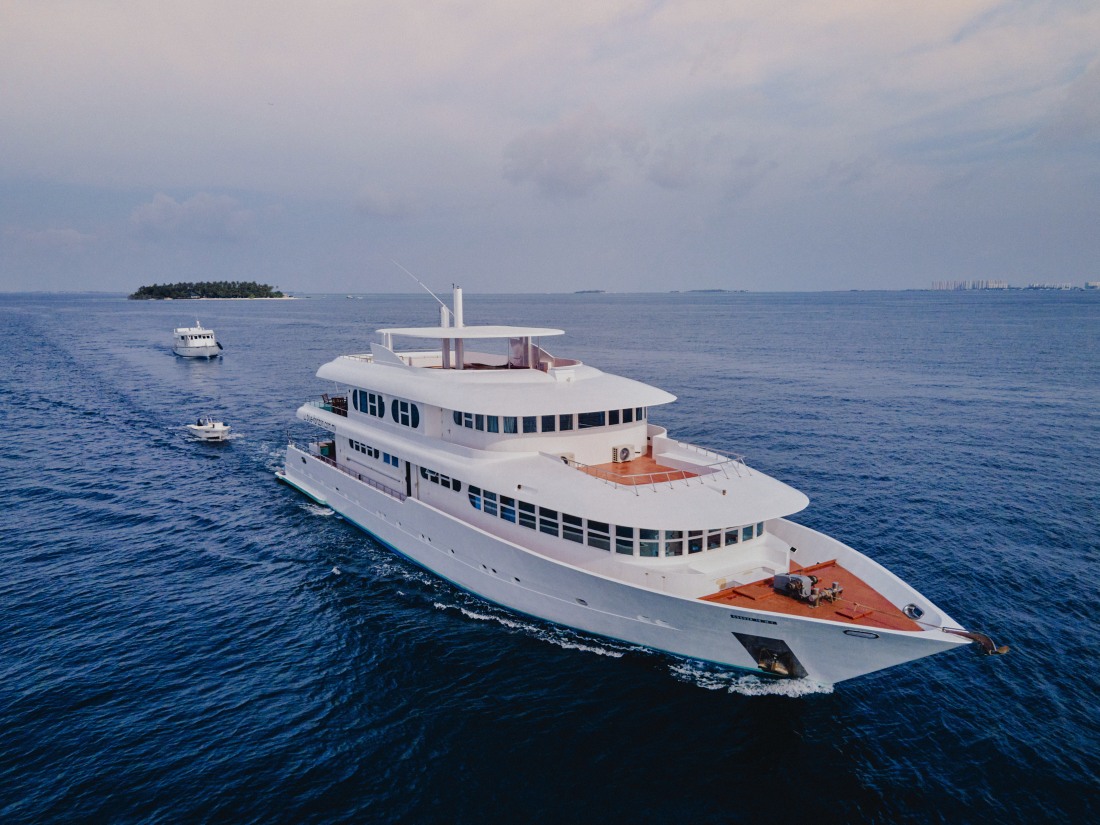Liveaboard Maldives
Liveaboard diving in the Maldives offers a unique adventure, combining the thrill of exploring marine life with the comfort of a floating hotel. This experience allows divers to reach remote dive sites and enjoy exclusive encounters with underwater species.

Understanding Liveaboard Lifestyle
The liveaboard lifestyle in the Maldives revolves around diving, relaxing, and enjoying the ocean. These boats are fully equipped to provide both luxury and functionality. Divers spend their days moving between isolated dive sites, which would be difficult to access otherwise.
Amenities: Liveaboards in the Maldives come with air-conditioned cabins, en-suite bathrooms, dining areas, and sometimes, spas or small pools. This ensures a comfortable stay onboard.
Daily Routine: Typically, the routine is simple: dive, eat, relax, and sleep. This continuous access to diving locations allows divers to maximize their underwater time.
Engagement with nature is profound, with opportunities to see vibrant coral gardens, caves, and a variety of marine species including manta rays and whale sharks. The secluded nature of liveaboard diving also means lesser crowds, providing a peaceful diving experience.
Benefits of Liveaboard Diving Trips
Liveaboard diving trips in the Maldives offer numerous benefits. They grant access to pristine dive sites far from the crowded shorelines, creating an immersive and unparalleled diving experience.
Reach Remote Areas: Liveaboards can reach dive spots that are impossible to get to from the shore. This includes secluded reefs and underwater landscapes that are untouched by mass tourism.
Marine Life Diversity: Divers have the opportunity to see a diverse range of marine life. This includes manta rays, whale sharks, and vibrant fish species amid coral reefs. This makes the Maldives an exceptional diving destination.
Convenience: Living on a boat eliminates daily travel to and from dive sites. This saves time and energy, allowing more dives per day.
Liveaboard trips also mean tailored diving experiences. With the ability to plan and execute exploratory dives, liveaboards offer flexibility and adventure that land-based excursions cannot match. For an in-depth guide on scuba diving in the Maldives, you can explore more information about scuba diving opportunities.
Choosing the Right Liveaboard
Choosing the right liveaboard in the Maldives involves understanding the types available and the amenities provided. Consider your budget and needs to make an informed choice.
Types of Liveaboards
Liveaboards in the Maldives vary widely, from budget options to luxury vessels. Budget liveaboards offer basic amenities, suitable for cost-conscious travelers or those focused solely on diving. These boats typically feature shared cabins, basic meals, and simple dive facilities.
Luxury liveaboards, on the other hand, come with high-end amenities. These vessels often include spacious suites, fine dining, and premium dive services.
For instance, the Horizon III Liveaboard features high-quality cabins, making your stay comfortable and enjoyable.
Accommodation and Amenities
Accommodation on liveaboards can range from simple shared cabins to luxurious private suites. Budget liveaboards often provide functional sleeping arrangements with bunk beds and communal bathrooms. In contrast, luxury liveaboards offer private, ensuite cabins with views of the ocean.
Amenities can significantly enhance your experience. Luxury liveaboards might feature a spa for relaxation, a bar for socializing, and a jacuzzi for unwinding after dives. Comfortable lounges are common, providing places to relax between dives or in the evenings. When selecting a liveaboard, consider what amenities are important to you to ensure a pleasant and memorable trip.
Best Times and Places for Diving
Diving in the Maldives is influenced by seasonal changes and the variety of dive sites that offer unique experiences, from whale sharks to vibrant coral reefs.
Seasonal Variations in the Maldives
The Maldives experiences two main monsoon seasons. The northeast monsoon from December to May is ideal for diving. During this time, the sea is calmer, and visibility is higher, ranging from 15-20 meters. Water temperatures stay between 26-29°C, making for comfortable dives.
From June to November, the southwest monsoon brings stronger winds and more rain, which can affect diving conditions. However, this period is still popular among divers seeking encounters with manta rays and whale sharks. These creatures are more likely to be seen feeding on the plankton that thrives during this season.
Top Dive Sites in the Maldives
Ari Atoll is famous for its encounters with whale sharks and manta rays. Liveaboards often include this atoll in their itineraries, especially from December to May.
Hanifaru Bay is another excellent location, especially during the southwest monsoon. This site is renowned for attracting large numbers of manta rays.
South Malé Atoll features stunning coral gardens and reef sharks. This area provides diverse marine life and is accessible year-round.
North Malé Atoll includes sites like Banana Reef and Manta Point, both offering vibrant underwater scenery and frequent sightings of eagle rays and reef sharks.
Choosing the right time and place for your Maldives diving adventure ensures breathtaking underwater experiences with the region’s rich marine biodiversity.
Marine Life in Maldivian Waters
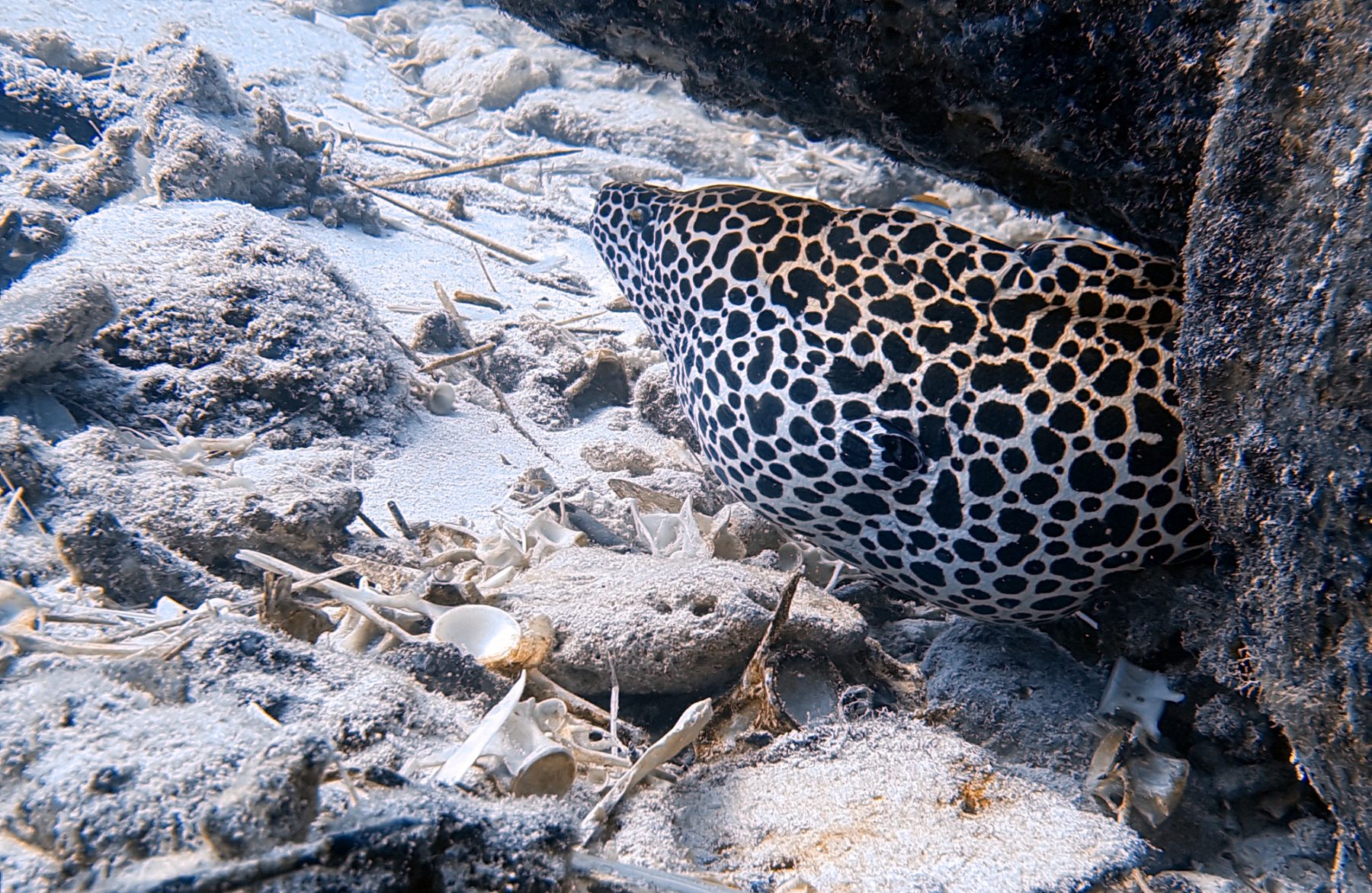
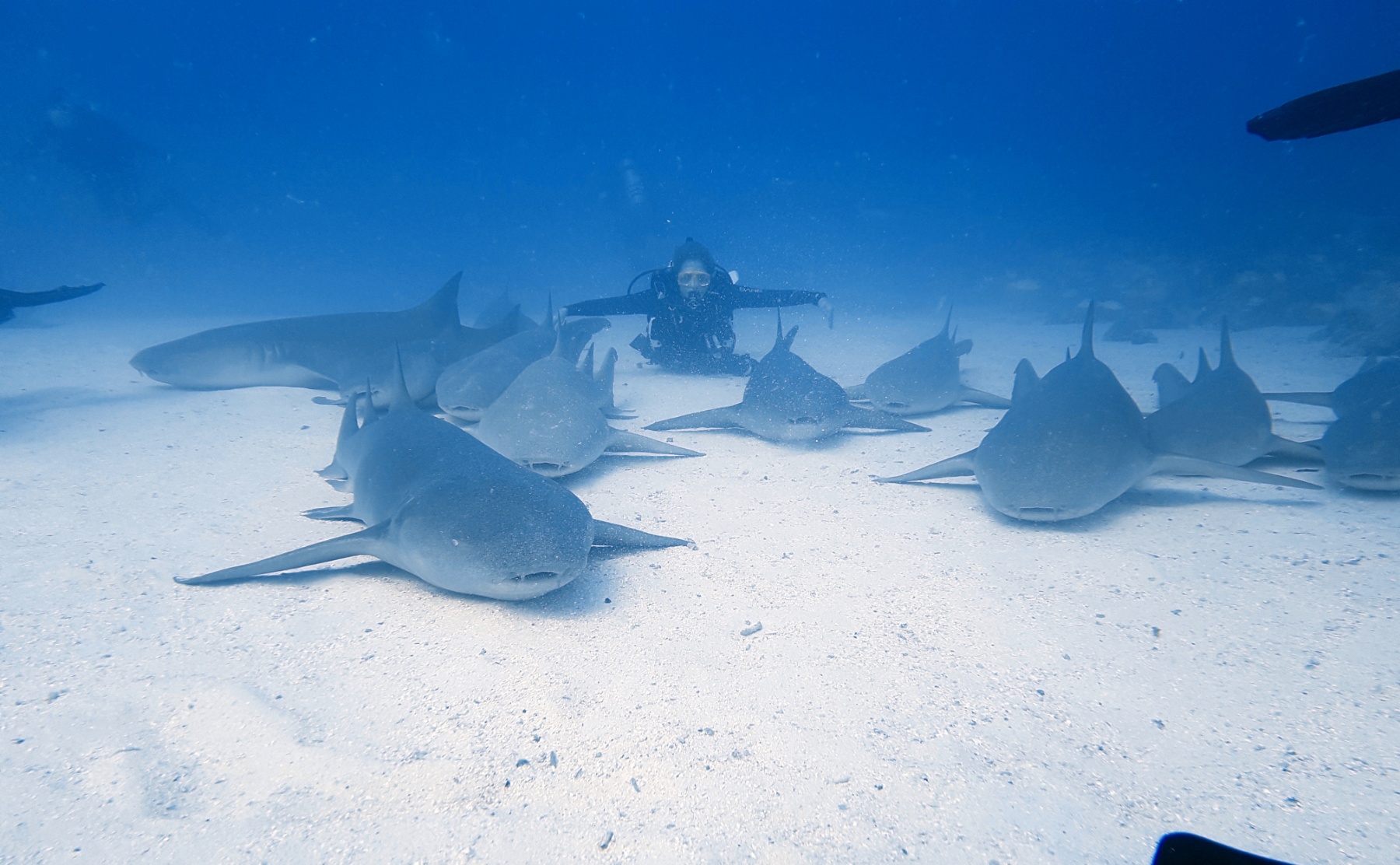 Maldivian waters boast a rich diversity of marine life, offering unforgettable encounters with species such as whale sharks, manta rays, and vibrant coral reefs. The underwater world here is both stunning and abundant, presenting unique opportunities for exploration and conservation.
Maldivian waters boast a rich diversity of marine life, offering unforgettable encounters with species such as whale sharks, manta rays, and vibrant coral reefs. The underwater world here is both stunning and abundant, presenting unique opportunities for exploration and conservation.
Common Marine Species Encounters
The Maldives is a hotspot for encountering a variety of marine species. Divers frequently see reef sharks patrolling the vibrant coral gardens. Among the many spectacular sights are the whale sharks, the largest fish in the ocean, known for their gentle demeanor.
Manta rays are another prominent feature. They are often spotted near cleaning stations where they interact with smaller fish. These rays can be seen gliding gracefully through the water, their large wingspans making an impressive display. The Maldives’ coral reefs are home to countless colorful tropical fish, soft and hard corals, and other invertebrates, making every dive a vibrant experience.
Pelagic species like tuna, barracuda, and trevally are also common, adding to the adrenaline rush for divers. Each dive site in the Maldives offers the possibility of new and incredible marine encounters.
Conservation of Marine Life
The Maldives places a strong emphasis on the conservation of its marine ecosystems. Efforts include protecting endangered species like whale sharks and manta rays. Marine protected areas have been established to safeguard essential habitats and promote biodiversity.
Coral reef restoration projects are also in place to address the damage caused by climate change and human activities. These initiatives involve planting new coral fragments and monitoring their growth. Sustainable tourism practices are encouraged, ensuring that visitors can enjoy the underwater world without causing harm.
Education and awareness campaigns help locals and tourists understand the importance of preserving marine life. Collaborative efforts between the government, local communities, and conservation groups aim to create a balanced relationship between human activity and the natural environment of the Maldives.
Specialty Diving Experiences
Specialty diving in the Maldives offers unique experiences such as night diving and drift diving. Divers can also explore the stunning coral atolls, filled with vibrant marine life and intricate underwater landscapes.
Night and Drift Diving
Night diving in the Maldives reveals a whole new underwater world. As the sun sets, marine life behavior changes dramatically. Coral polyps expand to feed on plankton, and nocturnal creatures like lobsters and lionfish become more active. Many liveaboards, such as the Horizon III Liveaboard are well-equipped for these dives.
Drift diving is another popular activity. The Maldives’ numerous channels and strong currents make it perfect for this type of diving. Divers let the current carry them along, allowing them to cover large areas with minimal effort. It’s an excellent way to encounter large pelagic species like manta rays and sharks. Some of the top-rated fleets, such as the Horizon III Liveaboard specialize in these dives.
Exploring Atolls
The atolls in the Maldives are famous for their beauty and biodiversity. These structures form natural barriers and are home to a variety of marine species. Divers can explore coral gardens, vibrant reefs, and underwater caves.
The Horizon III Liveaboard offers trips to these stunning sites. Each atoll boasts different dive spots, from shallow coral gardens to deeper walls teeming with colorful marine life. Exploring these atolls provides a chance to see both soft and hard corals, schools of tropical fish, and the occasional turtle or ray.
These specialty diving experiences in the Maldives stand out for their unique and exciting nature, making them a must-try for any diving enthusiast.
Equipment and Dive Preparation

Proper preparation and having the right gear are essential for a safe and enjoyable scuba diving experience in the Maldives. Focusing on accurate gear selection and thorough safety checks can make all the difference.
Selecting the Right Gear
When planning a diving trip in the Maldives, choosing the right equipment is crucial. Divers can bring their own diving gear or opt for gear rental from the liveaboard operator. Key items include a buoyancy control device (BCD), regulator, wetsuit, mask, and fins.
Wetsuits are important due to varying water temperatures, typically between 26-29°C. A 3mm wetsuit is usually sufficient but having an extra layer can be beneficial for extended dives.
Nitrox, a common option for liveaboard diving, allows for extended bottom time and reduces nitrogen absorption. Ensure to verify whether Nitrox is available and if certification is needed.
Horizon III Liveaboard is equipped with Nitrox and Nitrox Course can be conducted on board as well.
Safety Procedures and Checks
Safety should always be a top priority. Before diving, comprehensive safety checks are necessary. Inspect all gear for any signs of wear or damage. Ensure that the BCD inflates and deflates properly and that the regulator is delivering air smoothly.
Going through a pre-dive checklist with your buddy helps confirm all essential safety aspects. Key checks include verifying air supply, checking dive computers, and ensuring proper weighting for neutral buoyancy.
Liveaboard operators often conduct detailed briefings, covering emergency procedures, dive site specifics, and local marine life interaction guidelines. Following these protocols helps ensure a safe and enjoyable dive experience for all participants.
We at Blue Horizon Maldives take the guests safety as Top Priority.
Travel Logistics and Planning

Traveling to the Maldives for a liveaboard diving adventure involves careful planning. It’s important to understand the steps from arriving in the Maldives to embarking on your liveaboard journey and the various itinerary options available.
Getting to the Maldives
Most visitors arrive at Velana International Airport in Malé. There are numerous flights from major cities around the world. Once you land, you will need to transfer to your liveaboard’s departure port. Transfers are often by speedboat or domestic flight, depending on the distance.
Travelers should check with their liveaboard operator about the transfer schedule to ensure smooth transitions from the airport to the boat. Planning these details in advance helps avoid any last-minute issues.
Horizon III Liveaboard picks all the guests from the Airport and then drops them back to the airport on last day.
Liveaboard Itineraries
Liveaboard itineraries in the Maldives typically last between 7 to 10 days. Options vary based on your budget and interests.
Itineraries often include diving sites famous for diverse marine life such as whale sharks and manta rays. The trip may cover central, northern, or southern atolls, each offering unique underwater experiences. It’s essential to review the itinerary details with the operator to ensure it aligns with your diving goals.
Accompanying Non-Divers
Non-divers on liveaboards in the Maldives have plenty to look forward to, including relaxing spa facilities and engaging activities. Many liveaboards cater to both divers and their non-diving partners, ensuring everyone enjoys their vacation.
Activities for Non-Diving Partners
Non-diving partners can enjoy a range of activities while aboard a liveaboard. Fishing trips are a common offering, allowing guests to experience the thrill of catching fish in the beautiful Maldivian waters. Those interested in exploring the islands can participate in organized island excursions, discovering local cultures and pristine beaches.
Some liveaboards feature snorkeling trips, enabling non-divers to experience the vibrant marine life from the surface. For those interested in marine biology, marine life talks and photo workshops are sometimes available, offering fascinating insights into the underwater world.
Liveaboard Facilities for Relaxation
Relaxation is a key focus for non-divers on liveaboards. Many offer top-notch spa services with professional therapists. Treatments like massages and facials provide a serene escape.
Outdoor dining is another highlight, where guests can enjoy meals with spectacular views of the ocean. The lounge areas are perfect for unwinding with a good book or socializing with other passengers.
Some liveaboards also provide yoga sessions on deck, promoting physical and mental well-being. These amenities ensure that non-diving partners have a memorable and enjoyable time on board.
Economic and Environmental Impact
Liveaboard diving in the Maldives has significant effects on both the local economy and the marine environment. The economic benefits are substantial, while environmental sustainability practices are crucial to preserving the delicate marine ecosystems.
Liveaboard Tourism on Local Economies
Liveaboard tourism in the Maldives injects considerable revenue into local economies. Small island communities benefit from the influx of tourists through job creation. Locals find employment opportunities as boat crew, dive guides, or in hospitality roles on the vessels.
Many liveaboards also purchase supplies from local markets, maintaining a steady demand for local products. This boosts the income of local farmers, fishers, and artisans. Additionally, tourism taxes and fees paid by liveaboard operators contribute directly to national and regional development projects.
Overall, liveaboard companies may often engage in collaborations with local businesses, enhancing the economic linkages. This mutual support enhances the resilience and prosperity of these island economies.
Sustainable Diving Practices
Sustainable diving practices are critical for preserving the Maldives’ coral reefs and marine life. Many liveaboard operators are dedicated to environmental conservation by following strict guidelines. These include limiting the number of dives per site and ensuring proper waste management.
Some liveaboards participate in coral reef restoration projects. Divers may assist in planting coral fragments or removing invasive species that threaten local ecosystems. These activities help maintain the biodiversity and health of the reefs.
Efforts to educate tourists about marine conservation are also significant. Onboard briefings and presentations emphasize the importance of not touching corals and maintaining neutral buoyancy to avoid damaging the delicate underwater habitats. Reducing the carbon footprint by adopting energy-efficient systems further supports sustainability.
Adhering to these practices helps ensure that the marine environment remains vibrant for future generations.
Frequently Asked Questions
Various aspects make Maldives liveaboard diving trips appealing, from costs and amenities to required diving experience and trip duration. Understanding these can help in planning a memorable experience.
What are the typical costs involved in a Maldives liveaboard diving trip?
The cost of a Maldives liveaboard diving trip typically ranges from $1,600 to $4,000. This usually includes diving, food, and drinks. Depending on the choice of vessel and luxury level, prices may vary.
How many days are usually recommended for a liveaboard experience in the Maldives?
Most liveaboard itineraries in the Maldives are around 7-10-14 days. This duration allows divers to explore multiple diving sites and enjoy the beauty of various atolls.
What should one look for when reading reviews about Maldives liveaboard trips?
When reading reviews, focus on the quality of diving sites visited, safety measures, and the experience level of the crew. Reviews often highlight the overall service quality, comfort of the accommodations, and the freshness of the food served.
What amenities can be expected on a luxury liveaboard in the Maldives?
Luxury liveaboards in the Maldives typically offer ensuite showers, spacious cabins, air conditioning, and high-quality dining options. Some even provide additional features like spa services and non-diving activities for companions.
Can liveaboard packages in the Maldives include flights?
While most liveaboard packages do not include flights, it is always best to confirm with the service provider. Some premium packages or travel agencies might offer all-inclusive deals that cover both the liveaboard experience and flights.
What is the required level of diving experience for joining a Maldives liveaboard excursion?
Liveaboard diving in the Maldives generally demands a higher level of diving certification and experience. The strong currents and deep dives can be challenging, making it more suitable for advanced divers.
Book Your Next Dive Liveaboard Trip In The Maldives Horizon III Liveaboard
